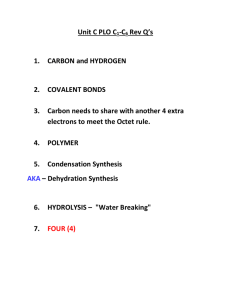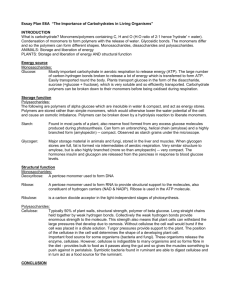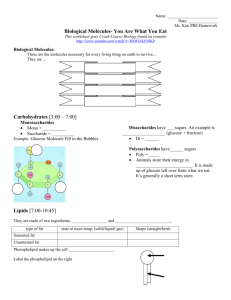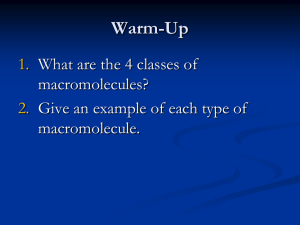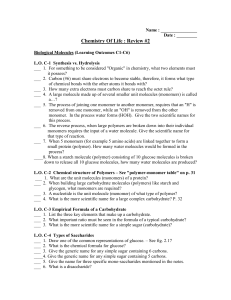Review Questions
advertisement
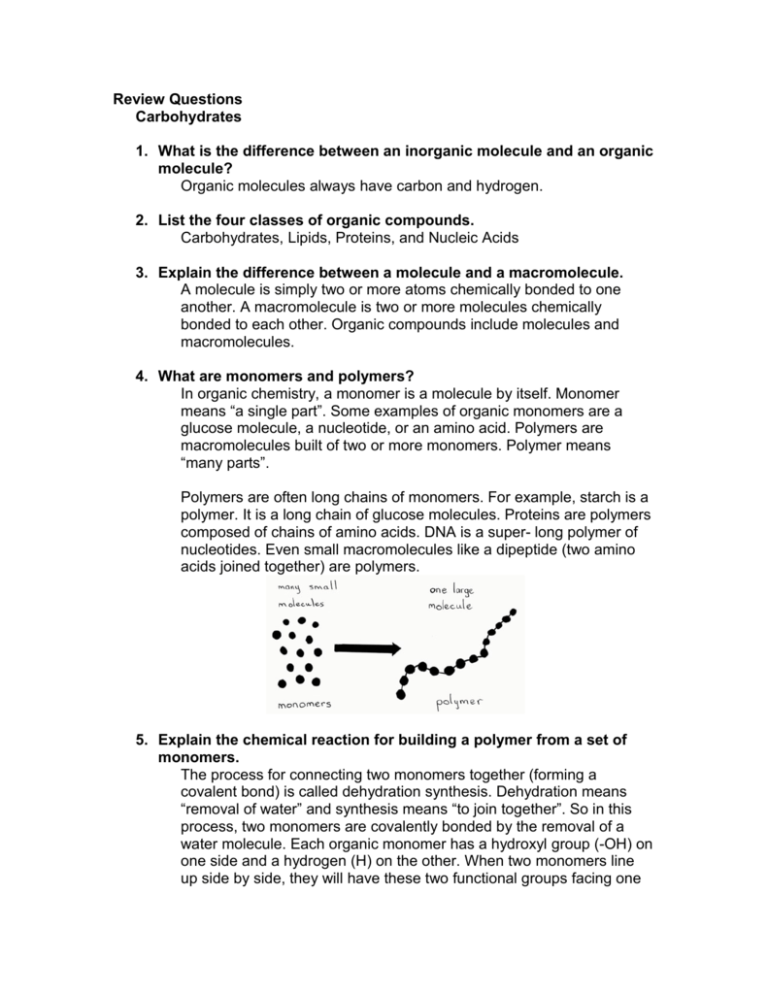
Review Questions Carbohydrates 1. What is the difference between an inorganic molecule and an organic molecule? Organic molecules always have carbon and hydrogen. 2. List the four classes of organic compounds. Carbohydrates, Lipids, Proteins, and Nucleic Acids 3. Explain the difference between a molecule and a macromolecule. A molecule is simply two or more atoms chemically bonded to one another. A macromolecule is two or more molecules chemically bonded to each other. Organic compounds include molecules and macromolecules. 4. What are monomers and polymers? In organic chemistry, a monomer is a molecule by itself. Monomer means “a single part”. Some examples of organic monomers are a glucose molecule, a nucleotide, or an amino acid. Polymers are macromolecules built of two or more monomers. Polymer means “many parts”. Polymers are often long chains of monomers. For example, starch is a polymer. It is a long chain of glucose molecules. Proteins are polymers composed of chains of amino acids. DNA is a super- long polymer of nucleotides. Even small macromolecules like a dipeptide (two amino acids joined together) are polymers. 5. Explain the chemical reaction for building a polymer from a set of monomers. The process for connecting two monomers together (forming a covalent bond) is called dehydration synthesis. Dehydration means “removal of water” and synthesis means “to join together”. So in this process, two monomers are covalently bonded by the removal of a water molecule. Each organic monomer has a hydroxyl group (-OH) on one side and a hydrogen (H) on the other. When two monomers line up side by side, they will have these two functional groups facing one another (H & OH). The H and the OH will break off of their respective monomers and bond forming a water molecule. This is the dehydration part of the process. Each monomer now has a carbon atom that needs to covalently bond with something, so they bind to each other forming a polymer. That is the synthesis part of the process. Dehydration synthesis is an energy-requiring process. Every time a cell needs to build a protein or a starch, it has to expend some energy to form those chemical bonds. Dehydration synthesis is universal for building all organic polymers. 6. Explain the chemical reaction for breaking down a polymer into individual monomers. The process of splitting the bond between monomers is called hydrolysis. Hydrolysis means “to break with water”. Since a water molecule was lost during dehydration synthesis, hydrolysis brings the water back. To separate the monomers, the functional groups H and OH that broke off in the bonding have to be reattached to their respective monomers. So first the covalent bond is broken between the two carbons holding the two monomers to each other and then a water molecule is introduced. The water molecule splits into a H and an OH and these attach to their respective monomer. Hydrolysis is an energyreleasing process. Living organisms harvest energy from chemical bonds through hydrolysis. Like dehydration synthesis, hydrolysis is universal for breaking down all organic polymers. 7. List the names of the monomers and polymers of the four classes of organic compounds. Class Carbohydrates Lipids (neutral fats) Proteins Nucleic Acids Monomer monosaccharide glycerol and fatty acid amino acid nucleotide Polymer polysaccharide triglyceride polypeptide polynucleotide 8. What is a carbohydrate? Carbohydrates are the sugars and starches. Every kind of carbohydrate has to have carbon, hydrogen, and oxygen. Plus, the ratio of C, H, O is always 1:2:1. CH2O is a common way to represent this ratio. The term “carbohydrate” comes from the observation that the molecule is a carbon linked to a water molecule (C – H2O), “hydrate” meaning water. You can often recognize a carbohydrate by its suffix – ose (e.g. glucose, sucrose, cellulose, etc.) 9. Describe the monosaccharides. Monosaccharides are the monomers of carbohydrates and are often referred to as “the simple sugars”. There are dozens of them but they are classified according the number of carbons they contain. For example, glucose has 6 carbons and belongs to a group of monosaccharides called the hexose sugars: “hex” meaning 6. Triose sugars, like glyceraldehyde, have 3 carbons. Pentose sugars, such as ribose, have 5. Monosaccharides range from 3 to 7 carbons. We are going to focus on 3 hexose sugars that organisms use for fuel: glucose, fructose, and galactose. Glucose, also known as dextrose, has the empirical formula C6H12O6. Glucose is the main energy source for life. We often call it blood sugar. Some organs in our body feed on nothing but glucose; our brain, for instance. Fructose has the exact same empirical formula as glucose: C6H12O6. Fructose is also known as levulose. Sweeter than the other 2 hexose sugars, fructose is commonly found in fruits and honey. Since fructose is sweeter, less is required, and so it is cheaper. High fructose corn syrup is now the major sugar source for soft drinks. Galactose, just like glucose and fructose, is C6H12O6. Galactose is rarely found free. Bonded to glucose, it forms lactose or milk sugar. Once ingested, both fructose and galactose are converted into glucose for an organism’s energy needs. 10. What are isomers? You may have noticed that glucose, fructose, and galactose all have the same formula C6H12O6. Then why are they different? Well, it is because they have different structures. Molecules with the same empirical formula but different structures are known as isomers. Slight changes in structure give these molecules unique properties. There are a variety of different types of isomers: structural, geometric, and enantiomers (optical), just to name a few. 11. Describe the disaccharides. As the name implies, disaccharides are two monosaccharides covalently bonded together. This covalent bond is called a glycosidic linkage. Dehydration synthesis is how disaccharides are built. There are 3 disaccharides we will review: maltose, sucrose, and lactose. Maltose is a polymer composed of two glucose molecules. Maltose is produced by germinating grains as they break down their starchy endosperm. We feed this disaccharide to yeast when we make beer and whiskey. Sucrose is glucose and fructose bonded together. Sucrose is table sugar or cane sugar. We also find it in honey and maple syrup. Lactose is milk sugar and is built from glucose and galactose. Most of the world’s population has some level of lactose intolerance (70%). The lactose-intolerant lack the enzyme lactase to break down the sugar in the small intestines. Lactose in the large intestine acts as a sponge and water remains in the large intestine resulting in diarrhea and abdominal cramping. Thanks to recent developments, dairysensitive folks can now enjoy milk by taking a pill containing lactase. 12. Describe the oligosaccharides. Oligo” means “few”. So oligosaccharides, like raffinose and stachyose, are small chains of monosaccharides. In the figure below, raffinose (sucrose + galactose) is on the left and stachyose (sucrose + 2 galactose) on the right. We lack the enzyme to break these down but the bacterial flora in our gut do. Certain foods are rich in these sugars and create extra flatus. The gaseous effects of foods, like beans and the cruciferous vegetables, can be reduced by taking a dose of the enzyme (Beano). 13. Describe the polysaccharides. Complex carbohydrates like starch, glycogen, cellulose, and chitin are long polymers of monosaccharides. Starch comes from plants and is a long-term storage form of sugar. Starch is also the major source of food for every human culture. A relatively simple macromolecule, it is built of many repeating units of glucose held together by glycosidic linkages. If you examine the cells of a potato under a microscope, the starch molecules are compacted into oval bodies called starch granules. Adding a little iodine to the potato turns the starch blue-black and the granules will pop into view. Animals also store starch but we call it glycogen. Glycogen literally means “agent that initiates sugar”. Just like plant starch, glycogen is a long polymer of glucose. Glycogen is stored in our liver and muscles. We have on hand about 24 hour supply of glycogen in our liver. If we skip a meal, our blood sugar will drop and the pancreas will release a hormone called glucagon. Glucagon stimulates the liver to break down enough of its store of glycogen into glucose to return our blood sugar levels to normal. Like plant starch, glycogen is stored as concentrated granules in the cells of the liver. Cellulose is another long polymer of glucose. Plant cells make their cell walls out of cellulose. In fact, 100 billion tons of cellulose is made every year on earth. Cellulose is indigestible in most animals, including us. Ever eat a cardboard box? You get the picture. We simply lack cellulase, the enzyme that can break it down. Some bacteria, some single-celled protists, and fungi have the enzyme. Animals that feed on cellulose harbor these microbes that help them digest it. Even though, we cannot break down this molecule, we do need cellulose in our diet. We call it “fiber”. Cellulose stimulates the colon to produce regular bowel movements and helps make the stools large and soft. A diet rich in fiber can prevent a painful intestinal disorder called diverticulosis. Hard impacted stools can sometimes cause the walls of the colon to form blind outpockets called diverticula which can periodically inflame. So what makes cellulose different from starch? Isn’t it made of glucose? Well it is but the glucose monomers are organized in an interesting fashion. The orientation of the glucose molecules alternates. So if the first one is right side up, the next one is upside down and then the next is right side up and the next one is upside down. Apparently this is a tricky arrangement for an enzyme to break. Chitin is similar in structure to cellulose. The only difference is that is has some nitrogen-containing side chains stuck to it. Chitin is strong, lightweight, and waterproof. Arthropods build their exoskeletons out of chitin. The cell walls of fungi are made out of it too. 14. What are the major functions of carbohydrates? Carbohydrates supply quick and short-term energy. Carbohydrates are a structural material. Plants, fungi, bacteria, and arthropods build their bodies with it. Carbohydrates are the raw material to make proteins, lipids, and nucleic acids. For example, plants make glucose first and then all their other organic compounds are built from that. Principal Carbohydrates Subtypes Monosaccharides Disaccharides Oligosaccharides Polysaccharides Examples Glucose Fructose Galactose Maltose Sucrose Lactose Raffinose Stachyose Starch (Amylose) Glycogen Cellulose Chitin


